Introduction
Grade 11 Biology students at Havergal College, a secondary school for girls in Ontario, Canada, have created a wide variety of treehouses on organisms such as watermelon snow, black mambas, clownfish, ostriches, pacific treefrogs and more! We highly recommend checking out these fun, creative and educational story, game, art and culture and investigation treehouses.
Portfolio Pages
Investigations- Jellyfish, "Stinging Creatures"
-

- The class Scyphozoa can be found in the phylum of Cnidaria, the phylum of the “stinging” creatures, such as jellyfish. There are approximately 200 species that belong to the class Scyphozoa, and they are the most familiar of the gelatinous creatures of our world. These include, sea nettles, moon jellies and jellyfish. The jellyfish found in this class are dubbed "the true jellyfish". Many people associate the Portuguese Man-of-War and other well-known jellyfsh-like creatures with these Scyphozoans. However, in fact, the Portuguese Man-of-War and these other species are not "true" jellyfish. Yes, they have sac shaped bodies and long tentacles that sting painfully, but they are still structured differently than those organisms of Class Scyphozoa. And, hence, they are not "true" jellyfish.
- Polytrichum commune
-
 © James K. Lindsey
© James K. Lindsey
- Moss. What comes to mind when you hear “moss”? Probably an image of that useless green fuzz you see on rocks when you’re hiking or in your neighbor’s garden, but there is more to moss then meets the eye. By looking over this website you will find the answers to questions you never even thought to ask about an organism as seemingly boring as moss. Next time you come across that bit of green fuzz you will not leave unimpressed.
- Sponge Investigation
-
 © sponge1
© sponge1
- Sponges are the simplest of multi-cellular animals.
- About Sponges
-
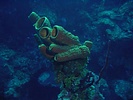 © 2004 Dlloyd
© 2004 Dlloyd
- Sponges are the simplest form of multi-cellular animals. They are very diverse and come in a large variety of colours, shapes and structural complexities. They range in heights of 1-200cm and in diameters of 1-150cm. They have partially differentiated tissues, and not true tissues. Sponges don’t have internal organs. They don’t have muscles, a nervous system, or a circulatory system. Their walls are lined with many small pores called ostia that allow water flow into the sponge.
- Bertha the Beluga Whale
-
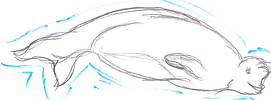 © 2005 beluga1
© 2005 beluga1
- Once upon a time in a frigid land of ice and snow, there lived a pleasant beluga (beluga whales, Delphinapterus Leucas) named Bertha.
- Clownfish Story
-
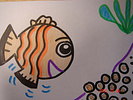 © 2005 fish1
© 2005 fish1
- Once upon a time, in the depths of the ocean, there were hundreds of tiny fish eggs lying peacefully inside the protection of a sea anemone with a loving father who looked after them. An impatient little clownfish named Mone was the first larvae to hatch among his brothers and sisters...
- Confessions of an Ostrich
-
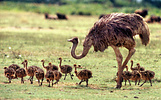 © 2005
David Bygott
© 2005
David Bygott
- Hi there! My name is Daneka, and I am an ostrich. I don't live in a zoo, or on a farm like a lot of ostriches do, I live in a desert in Central Africa with other ostriches. You may wonder, how is it possible for us ostriches to survive in such a hot, dry climate? Well, let me tell you...
- Interview with a Feather Star
-
© 2005 echinoderm2
- An Interview with a Feather Star (Also Known as a Crinoid). Barbara Waters: Hi, welcome to our one-time interview with the ocean-wide sensation, Feather Star!! I'm Barbara Waters, reporting live from the coral reef at the largest ocean current off the coast of Australia! Welcome, Feather Star! Feather Star: Thank you, Barbara!! I'm delighted to be here!
- Interview with an Octopus
-
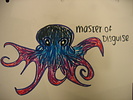 © 2005 octopus2
© 2005 octopus2
- Presenting and interview with an octopus, the master of disguise. Learn about the Common Octopus: Its Appearance, Habitat, Importance to Ecosystem, Interactions, Adaptations, Reproduction, Life Cycle and More!
- La Mamba Noire (in English)
-
 © 2005
David Bygott
© 2005
David Bygott
- Extra Extra! Read all about it. Read about the black mamba olypmics, the dwindling rodent stock in the northern quadrant of Somalia, and browse the real estate classifieds for news of dens and lairs for sale.
- Mollusk: Littleneck Clams!
-
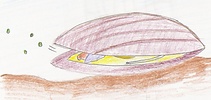 © mollusk2
© mollusk2
- Read about Mercenaria's underwater adventure. Once upon a time, deep in a less-salty bay, there lived a little clam by the name of Mercenaria mercenaria. Mercenaria and his family lived burrowed in the shallow, soft, muddy bottom of the bay.
- Oscar the Ostrich
-
 © Ostrich1
© Ostrich1
- In this story about two kids on an adventure with an ostrich in Africa, bolded lines are actual facts about ostriches.
- Memoirs of a Pacific Treefrog
-
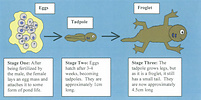 © 2005 frogerin2
© 2005 frogerin2
- Hello, my name is Fred. I am a Hyla regilla. Do you know what that is? Well, it means that I am a Pacific Treefrog. If you live on the west coast of North America, you have probably seen me or one of my buddies around. Even if you have not, this scrapbook I have made about my life will tell you everything you could ever want to know about Pacific Treefrogs. In my scrapbook, you will find out about how I was born, what I look like, where I live, what adaptations I have made to my environment, my contribution to my ecosystem, my mating habits, and what happens in the average day in the life of a male Pacific Treefrog.
- Squishy the Jellyfish
-

- Once upon a time, there was a Moon Jellyfish named Squishy. Squishy lived with his mom and dad in the Gulf of Mexico.
- Squirt, The Earthworm
-
© earthworm1
- The story of squirt on the way to his first day at at school.
- The California Sea Cucumber
-
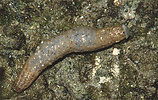 © Marine Discovery
© Marine Discovery
- In this PowerPoint presentation you will follow Purple-Urple the Star Fish as he guides you on a tour of the ocean and tells you about the family of his cousin, Squishy, the California sea cucumber!
- Snapping Turtle Story
-
© turtle1
- Read about the life of Bob the snapping turtle.
- Aurelia Aurita, Moon Jelly
-
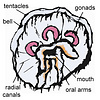 © jellyfish1
© jellyfish1
- Moon jelly, or Aurelia aurita, are probably the most common and widely recognized type of jellyfish. This board game through trivia questions, teaches about the Moon Jelly - general information, habitat, body system, and life cycle.
- The "Red" Green Algae
-
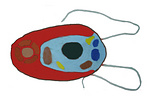 © algae2
© algae2
- Although known for its bright pink-red colour, watermelon snow, scientifically known as Chlamydomonas nivalis, is actually a species of green algae. While most forms of green algae thrive in fresh water habitats, C. nivalis can be found within the snowfields of mountains and on top of glaciers; this is surprising as other species of green algae would not be able to survive in such a harsh, cold environment.
- Black Widow Spider
-
 © spider2
© spider2
- This exercise is meant to serve as a tool to help students learn about the Black Widow Spider. It provides information so students will have a basic understanding about where the Black Widow lives, what it eats, and how it interacts with other spiders. This craft is not only educational but fun to make as well!
- The Sea Star Song
-
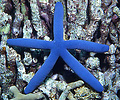 © 2003 Massimo Boyer
© 2003 Massimo Boyer


 Go to quick links
Go to quick search
Go to navigation for this section of the ToL site
Go to detailed links for the ToL site
Go to quick links
Go to quick search
Go to navigation for this section of the ToL site
Go to detailed links for the ToL site